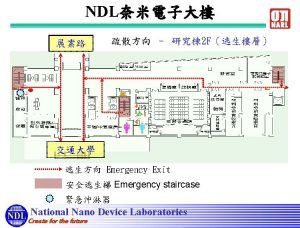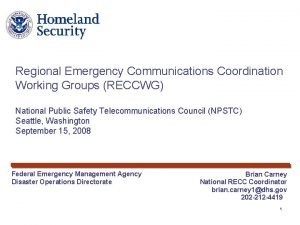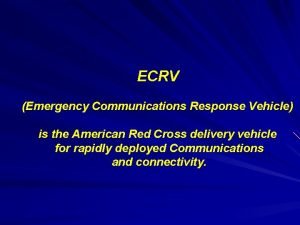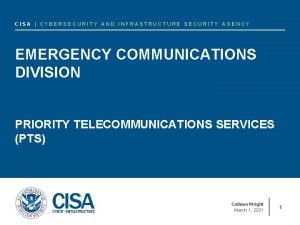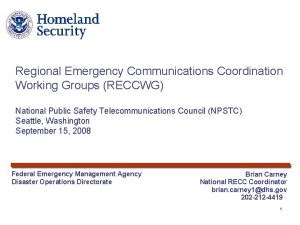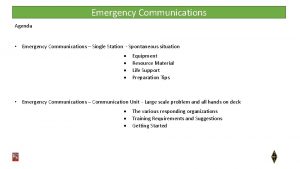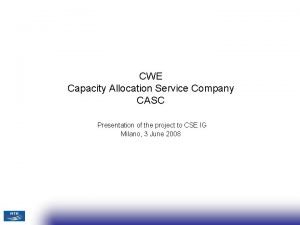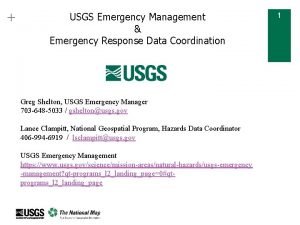Regional Emergency Communications Coordination Working Groups RECCWG National















- Slides: 15

Regional Emergency Communications Coordination Working Groups (RECCWG) National Public Safety Telecommunications Council (NPSTC) Seattle, Washington September 15, 2008 Federal Emergency Management Agency Disaster Operations Directorate Brian Carney National RECC Coordinator brian. carney 1@dhs. gov 202 -212 -4419 1

Agenda • • Issue Title XVIII Legislation RECCWG as a coordination point RECCWG Draft Management Directive RECCWG Vision Resource Issues National Emergency Communications Plan (NECP) Reporting Requirement • Discussion 2

Issue The goal of operable, interoperable and survivable communications can only be realized through close coordination with Emergency Response Organizations and Partners. 3

Title XVIII Legislation The Department of the Homeland Security Act of 2002, as amended (P. L. 109 -295), section 1805)d) established the RECCs. a) IN GENERAL. —There is established in each Regional Office a Regional Emergency Communications Coordination Working Group (in this section referred to as an ‘RECC Working Group’). Each RECC Working Group shall report to the relevant Regional Administrator and coordinate its activities with the relevant Regional Advisory Council. b) MEMBERSHIP. —Each RECC Working Group shall consist of the following: (continued on next slide) 4

Title XVIII Legislation (Cont. ) Membership (1) NON-FEDERAL. —Organizations representing the interests of the following: (A) State officials. (B) Local government officials, including sheriffs. (C) State police departments. (D) Local police departments. (E) Local fire departments. (F) Public safety answering points (9– 1– 1 services). (G) State emergency managers, homeland security directors, or representatives of State Administrative Agencies. (H) Local emergency managers or homeland security directors. (I) Other emergency response providers as appropriate. (2) FEDERAL. — Representatives from the Department, the Federal Communications Commission, and other Federal departments and agencies with responsibility for coordinating interoperable emergency communications with or providing emergency support services to State, local, and tribal governments 5

Title XVIII Legislation (Cont. ) RECC Coordination Responsibility (c) COORDINATION. —Each RECC Working Group shall coordinate its activities with the following: (1) Communications equipment manufacturers and vendors (including broadband data service providers). (2) Local exchange carriers. (3) Local broadcast media. (4) Wireless carriers. (5) Satellite communications services. (6) Cable operators. (7) Hospitals. (8) Public utility services. (9) Emergency evacuation transit services. (10) Ambulance services. (11) HAM and amateur radio operators. (12) Representatives from other private sector entities and nongovernmental organizations as the Regional Administrator determines appropriate 6

Title XVIII Legislation (Cont. ) RECC Duties The Department of the Homeland Security Act of 2002, as amended (P. L. 109 -295), section 1805 assigns the following to the RECCs. (d) DUTIES. —The duties of each RECC Working Group shall include— (1) assessing the survivability, sustainability, and interoperability of local emergency communications systems to meet the goals of the National Emergency Communications Plan; (2) reporting annually to the relevant Regional Administrator, the Director for Emergency Communications, the Chairman of the Federal Communications Commission, and the Assistant Secretary for Communications and Information of the Department of Commerce on the status of its region in building robust and sustainable interoperable voice and data emergency communications networks and, not later than 60 days after the completion of the initial National Emergency Communications Plan under section 1802, on the progress of the region in meeting the goals of such plan; 7

Title XVIII Legislation (Cont. ) RECC Duties (Cont. ) (3) ensuring a process for the coordination of effective multijurisdictional, multiagency emergency communications networks for use during natural disasters, acts of terrorism, and other man-made disasters through the expanded use of emergency management and public safety communications mutual aid agreements; and (4) coordinating the establishment of Federal, State, local, and tribal support services and networks designed to address the immediate and critical human needs in responding to natural disasters, acts of terrorism, and other manmade disasters. 8

RECCs as a Coordination Point • Proposal – Ø Establish and use the RECC’s as a single Federal emergency communications coordination point for Federal interaction with the State, local and tribal governments. Ø No Federal Office, Department or Agency would give up any of it’s authorities or responsibilities. Ø Eventually all Federal Offices, Departments, and Agencies will coordinate their regional activates with the Regional administrator via the RECC thus minimizing different or conflicting advice or guidance to the State, local or Tribal officials. 9

FEMA RECCWG Draft Management Directive Overview RECCWGs shall: • Assess the survivability, sustainability, and interoperability of local emergency communications systems in order to meet the goals of the NRF and NECP. • Ensure a process for the coordination of effective multi -jurisdictional, multi-agency emergency communications networks for use during disasters through expanded use of emergency management and public safety communications mutual aid agreements. • Coordinate the establishment of Federal, State, local, and Tribal support services and networks designed to address the immediate and critical human needs in responding to disasters. • Provide a forum for discussion and guidance on emergency communications grants planning and applications processes and for supporting various regional emergency communications efforts. • Coordinate activities with: Regional Advisory Council, communications equipment manufacturers, healthcare providers, and other appropriate groups. • Advise the FEMA RA and other agency and government leaders on regional, state, local, Tribal emergency communications issues. Regional Administrators shall: FEMA’s Assistant Administrator for Disaster Operations shall: • Ensure RECCWGs successfully meet the emergency communications coordination needs of agencies within the region. • Ensure RECCWG membership and participation is representative of the agencies within the region. • Ensure RECCWG members are involved and equal partners in the RECCWG tasks. • Share findings and recommendations with the RAs of adjacent FEMA Regions to facilitate preparation for and response to disasters with cross regional boundaries. • Report annually on the status of its region in building robust and sustainable interoperable voice and data emergency communications networks. • Ensure compliance with the FEMA RECCWG Management Directive. • Through the FEMA DEC Division, provide policy guidance and strategic oversight to the RECCWGs and RAs. • In coordination with the Associate Deputy Administrator, provide a combined report from all FEMA Regions to the Office of Emergency Communications (OEC), the Chairman of the FCC, the Assistant Secretary for Communications and Information of the Department of Commerce, and the FEMA Administrator. ____________________ • Associate Deputy Administrator will ensure RECCWG guidance, training, and reporting are conducted and will manage coordination with other DHS entities. 10

RECC Vision Preparedness Response OEC ECPC Technical Assistance Coordination & Information Sharing Plan FEMA (Federal Agencies) Assets SOPs POCs Evaluate & Improve RECC Organize, Train & Equip Working Groups Assets SOPs POCs State & Local Agencies Existing Resources: DEC, TICP, SCIP, PSIC, CASM, HSGP Exercise 11

Resource Issues and Actions • RECC Activities currently not funded • FEMA HQ has converted 10 FTE (at GS-14 level) to regional positions • FEMA Disaster Operations Directorate has submitted FY 10 -14 Over Target budget required for National and Regional RECC support 12

Overview of NECP 60 Day Reporting Requirement • As noted earlier in Title XVIII Legislation, each RECC is required to provide a report on it’s regional progress in meeting the goals and milestones outlined in the NECP no later than 60 days of the Plan’s release. • The NECP was released by the Office of Emergency Communications (OEC) on July 31, 2008. • To meet the deadline of September 30, 2008, FEMA Disaster Operations Directorate assisted in the development of the progress memo for each of the Regions based on information from the Statewide Communication Interoperability Plans (SCIP), FEMA Disaster Emergency Communication (DEC) State Plans, and other available information. • Each Regions reviewed, verified, and submitted the final progress memo to FEMA Disaster Operations Directorate for final submission to the Director for Emergency Communications, the Chairman of the Federal Communications Commission, and the Assistant Secretary for Communications and Information of the Department of Commerce. 13

Regional Memo Structure The memos provide a current snapshot of the status of each RECCWG and the communications status of each state within the region. – Introduction—provides a general overview of the Region and describes the purpose of the memo. – Establishment of RECC Working Groups—discusses when the RECCWG was established and how many meetings have been held, identifies the RECC Coordinator, and summarizes the main topics of discussion and outcomes of the RECCWG meetings. – Current Status of Interoperable Communications—identifies completed and planned regional efforts to better understand each State’s communications vulnerabilities, and describes the current status of interoperable and disaster emergency communications capabilities for each State, as well as planned activities to enhance interoperable communications in each State. – Planned Activities—identifies future activities the RECCWG will pursue to continue working with the States to better understand their communications capabilities and help address any of interoperable communications concerns discussed at the RECCWG meetings, as well as to maintain and strengthen RECCWG participation levels. – Challenges—describes several potential challenges that may impact the ability of the RECCWGs to maintain consistent participation from Federal, State, and local representatives, as well as meet the needs of the States and locals in improving interoperable communications. 14

Discussion 15
 National emergency communications plan
National emergency communications plan Reccwg
Reccwg Slidetodoc. com
Slidetodoc. com Communication coordination cooperation during the emergency
Communication coordination cooperation during the emergency Emergency communications response vehicle
Emergency communications response vehicle Cisa ecd
Cisa ecd Crisis communication working group
Crisis communication working group How are ethnic groups and religious groups related
How are ethnic groups and religious groups related Cigre working groups
Cigre working groups Tissues are groups of similar cells working together to
Tissues are groups of similar cells working together to Tissues are groups of similar cells working together to
Tissues are groups of similar cells working together to A group of cells similar in structure and function
A group of cells similar in structure and function Hard work vs smart work
Hard work vs smart work Advantage of hot working process
Advantage of hot working process Hot working and cold working difference
Hot working and cold working difference Machining operations
Machining operations
